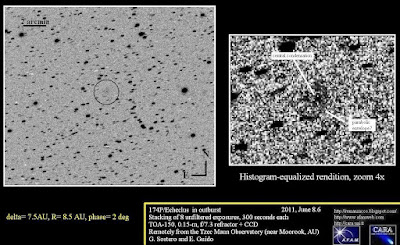Today, Monday June 27 at about 17:00 UT, the asteroid designated 2011 MD will pass only 12,300 kilometers (7,600 miles) above the Earth's surface. The asteroid was discovered by Linear survey with a 1.0-m f/2.15 reflector + CCD on June 22, 2011 at magnitude 18.9.
This object is only 5-20 meters in diameter and it is in a very Earth-like orbit around the Sun. Additional observations have made it possible to exclude that this object is a piece of space junk, as was suggested early on. Calculation by Bill Gray, a well-known expert on orbital dynamics, shows that this asteroid could not have been close enough to Earth any time during the space age to have started off as a rocket booster.
Trajectory of 2011 MD from the general direction of the Sun
We have been able to follow-up this object few hours ago remotely from the GRAS Observatory (near Mayhill, NM) through a 0.25-m, f/3.4 reflector + CCD and from the Faulkes Telescope South through a 2.0-m f/10.0 Ritchey-Chretien + CCD.
At the moment of our images from New Mexico on June 27, 06:50UT, "2011 MD" was moving at about 132"/min and its magnitude was ~15. While the images from FTS were obtained on June 27, 09:30UT when the asteroid was moving at about 176"/min and its magnitude was ~14.5.
At the moment of its close approach later today, 2011 MD will be bright as magnitude ~11.8
Below you can see our image taken with the 0.25-m, f/3.4 reflector + CCD in New Mexico, while 2011 MD was passing nearby a bright star (click on the image for a bigger version):

Here you can see a single 20-second exposure + RGB filter image taken by 2 meters telescope at Faulkes Telescope South (click on the image for a bigger version):


While this is an animation showing the object movement in the sky. Each image was 20-second exposure with Faulkes Telescope South 2 meters telescope. Click on the thumbnail to see a bigger version:
2011 MD's Earth flyby will be a close shave, but not a record for nearby passing asteroids. The record is currently held by the asteroid 2011 CQ1, which came within 5,480 kilometers of Earth on Feb. 4 of this year. See our previous post on this object:
http://remanzacco.blogspot.com/2011/02/2011-cq1-very-close-approach.html
by Ernesto Guido, Nick Howes and Giovanni Sostero
















